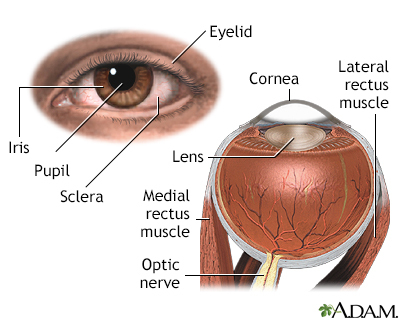Artificial heart gives a baby girl a second chance at life
This story is a follow-up to “How an artificial heart brought a bubbly baby’s smile back” that was published in January 2018. For more than half of her life,…

Update your location to show providers, locations, and services closest to you.
Watery eyes means you have too many tears draining from the eyes. Tears help keep the surface of the eye moist. They wash away particles and foreign objects in the eye.
Epiphora; Tearing - increased
Your eyes are always making tears. These tears leave the eye through a small hole in the corner of the eye called the tear duct.
Causes of watery eyes include:
Increased tearing sometimes happens with:
One of the most common causes of excess tearing is dry eyes. Drying causes the eyes to become uncomfortable, which stimulates the body to produce too many tears. One of the main tests for tearing is to check whether the eyes are too dry.
Treatment depends on the cause of the problem. Therefore, it is important to determine the cause before treating yourself at home.
Tearing is rarely an emergency. You should seek help right away if:
Also, contact your health care provider if you have:
The provider will examine your eyes and ask questions about your medical history and symptoms. Questions may include:
Your provider may order tests to help determine the cause.
Treatment depends on the cause of the problem.

Borooah S, Tint NL. The visual system. In: Innes JA, Dover AR, Fairhurst K, eds. Macleod's Clinical Examination. 14th ed. Philadelphia, PA: Elsevier; 2018:chap 8.
Olitsky SE, Marsh JD. Disorders of the lacrimal system. In: Kliegman RM, St. Geme JW, Blum NJ, Shah SS, Tasker RC, Wilson KM, eds. Nelson Textbook of Pediatrics. 21st ed. Philadelphia, PA: Elsevier; 2020:chap 643.
Örge FH. Examination and common problems in the neonatal eye. In: Martin RJ, Fanaroff AA, Walsh MC, eds. Fanaroff and Martin’s Neonatal-Perinatal Medicine. 11th ed. Philadelphia, PA: Elsevier; 2020:chap 95.
Seller RH, Symons AB. Vision problems and other common eye problems. In: Seller RH, Symons AB, eds. Differential Diagnosis of Common Complaints. 7th ed. Philadelphia, PA: Elsevier; 2018:chap 34.


This story is a follow-up to “How an artificial heart brought a bubbly baby’s smile back” that was published in January 2018. For more than half of her life,…

Think you can skip the disinfecting solution and pop a contact lens in after dropping it on your bathroom counter? You may want to think again. A new report…
